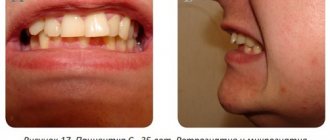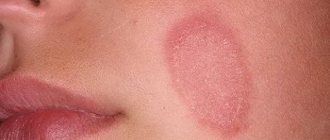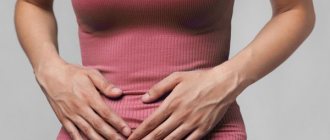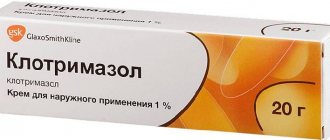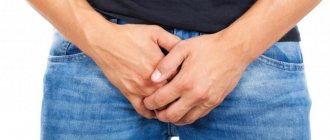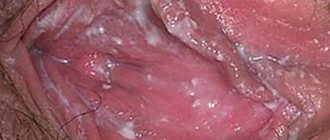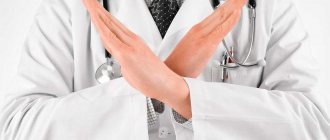Thrush, or candidal infection, accompanied by damage to the vaginal mucosa, is a problem for many women. The symptoms of this disease are so unpleasant that they completely knock the patient out of rhythm: due to severe itching, she cannot work normally, be sexually active, or even sleep peacefully.
THE COST OF AN APPOINTMENT WITH A GYNECOLOGIST IN OUR CLINIC IS 1000 rubles.
CLICK TO MAKE AN APPOINTMENT, TEST OR ULTRASOUND
Unfortunately, medications for thrush are advertised everywhere, which is why, having contracted candidiasis, women run not to the doctor, but to the pharmacy. After some time, the disease returns, which is natural, because such an infection cannot be cured with one pill; complex therapy is needed. That is why, at the first signs of thrush, you need to make an appointment with a good gynecologist and undergo full treatment. Today we will dispel myths about the treatment of thrush and formulate a number of recommendations that every woman should know.
Is thrush really a problem?
The content of the article
People of all ages suffer from candidiasis, with the peak incidence occurring between 20 and 40 years of age. According to statistics, 60% of women have been diagnosed with thrush at least once in their lives, and in 9%, candidiasis has a recurrent (repeating) course. In reality, this figure is higher, since in many patients the disease does not produce noticeable symptoms and the fungus is detected only when swabs are taken from the vagina.
The main problems of this pathology are self-medication, which leads to the disease becoming chronic, and negligent attitude towards one’s health. Gynecologists at the Diana Medical Center daily encounter cases of thrush, the severity of which is due to the patients’ late seeking of professional medical help.
Why thrush develops: causes of candidiasis
The main cause of the disease is fungi of the genus Candida. Normally, the fungus lives in the body of any person, but under certain circumstances, as a result of the influence of various predisposing factors, it begins to actively multiply. Therefore, such microorganisms are called opportunistic.
Normal vaginal microflora keeps the fungus from excessively multiplying. When it changes (dysbiosis), the growth of Candida increases, and thrush .
Stimulate the activation of infection:
- hormonal changes in the body: pregnancy, menopause, diseases of the endocrine system (diabetes, thyroid problems), incorrect selection of birth control pills;
- violation of personal hygiene rules and wearing synthetic underwear - the fungus loves dampness, warmth and does not like fresh air;
- douching, using aggressive cleaning agents;
- the presence of sexually transmitted infections, inflammation of the internal female organs, infection with thrush from a partner;
- diseases accompanied by changes in the concentration of sex hormones in the blood,
- pregnancy and chronic foci of infection in the body, weakening the immune system;
- uncontrolled use of antibiotics, which destroy, along with parasitic flora, beneficial lactobacilli - protectors of the mucous membrane.
It’s easy to provoke candidiasis: just walk around in tight synthetic panties in the heat. The fungus develops instantly in such conditions - it loves moisture, warmth, and does not need air.
Treatment of uncomplicated candidiasis
On pharmacy shelves you can find a whole range of remedies for thrush, both for local (creams, ointments, suppositories) and for systemic use (tablets). Local medications for self-medication are preferable because they do not enter the bloodstream, do not interact with other drugs, and do not cause systemic side effects. An example of such a drug with an optimal combination of effectiveness and safety is Pimafucin®.
Its active ingredient natamycin binds to sterols, the main components of fungal cell membranes. As a result, the integrity and functions of the membrane are disrupted, as a result of which the causative agent of the disease dies. This effect is called fungicidal (in contrast to fungistatic, which consists of suppressing the growth and reproduction of the fungus).
Pimafucin® is active against most yeast fungi; in the case of C. albicans, its effectiveness is close to 100%. In the vast majority of cases, for the treatment of uncomplicated candidiasis, it is enough to use one suppository per day for three days. Cases of resistance of yeast fungi to the drug have been observed extremely rarely in world practice.
In addition to its high effectiveness, Pimafucin® is advantageous in that side effects during its use are rare and consist only of slight temporary irritation of the vaginal mucosa.
At the same time, Pimafucin is approved for use at any stage of pregnancy and during breastfeeding; it is available from pharmacies without a prescription.
To solve specific problems, Pimafucin® is available not only in suppositories, but also in other dosage forms. If C. albicans is found in the intestines, Pimafucin® tablets are used, which act only in the lumen of the gastrointestinal tract, without being absorbed into the blood. If manifestations of candidiasis occur in a partner (itching, burning and redness of the skin under the foreskin), use Pimafucin® in the form of a cream. The same cream can be used in conjunction with suppositories to treat affected skin around the vaginal opening.
Is thrush contagious?
Keep in mind that candidiasis is a contagious disease and is easily transmitted to a sexual partner, so you will have to be treated together. The disease is often confused with an STD. In fact, thrush does not belong to this group, but contact with a man suffering from candidiasis will provoke the development of infection. A woman also transmits Candida to her partner. In men, thrush occurs more easily, this is due to good access of air to the mucous membrane of the head, but even without obvious signs, a once infected man becomes a carrier of the infection.
Symptoms of thrush: what a woman feels with candidiasis
Candidiasis is difficult to miss - it is one of the most unpleasant diseases. A woman is worried about incessant itching in the genital area, frequent painful urination (dysuria), pain and discomfort during sexual intercourse (dyspareunia), associated with vaginal dryness and injury. The main sign of fungal activity is a cheesy discharge. Whitish deposits begin to form on the reddened mucosa, which separate and form a cheesy vaginal discharge. In men, thrush manifests itself as redness of the head, a white coating accumulates on it, and red spots may form.
In advanced stages, the infection from the external genitalia spreads to the anal area. Cracks in the mucous membrane occur, accompanied by pain during defecation. If thrush is not treated, it becomes chronic and torments the woman constantly - during hypothermia, menstruation, after bathing, when personal hygiene rules are violated or in the premenstrual period, when hormonal levels change, etc.
Against the background of thrush, due to scratching and weakening of the natural flora of the vagina, a bacterial infection can develop, leading to bacterial vaginitis. Vaginitis quickly spreads to the uterus and its appendages, which in some cases can lead to decreased fertility (the ability to conceive), even to infertility.
If any symptoms of thrush appear, especially during pregnancy or breastfeeding, you should contact your doctor to confirm the diagnosis and prescribe timely treatment. The doctor makes a final diagnosis after receiving the test result (smear). A small amount of fungus does not cause disease and is normal.
Symptoms and signs
In women, candidiasis manifests itself with the following symptoms:
- redness and swelling of the mucous membranes of the labia majora and minora;
- sensation of itching and burning in the external genital area;
- pain during sexual intercourse and urination;
- the appearance of white, lumpy discharge with an unpleasant odor (may intensify on the eve of menstruation).
It is important to know that vaginal candidiasis is transmitted through sexual contact, so a woman can infect her partner.
Manifestation of thrush on the tongue. Source: Wikimedia, James Heilman,
Important: In men, candidiasis manifests itself with symptoms characteristic of urethritis and balanoposthitis: swelling and redness of the glans penis, which are often accompanied by rashes, itching, a white coating under the foreskin and a burning sensation in the urethra, which intensifies significantly during urination.
Formally, candidiasis is not considered a sexually transmitted infection. This is due to the fact that in its development the greatest role is played by an opportunistic fungus, which may be present in the vagina’s own microflora, so women who are not sexually active can also get thrush.
In most cases, a clear cause of thrush cannot be determined. Various conditions predispose to it, causing changes in microflora, mucus quality and acid-base balance of the vagina:
- taking antibiotics;
- pregnancy;
- taking estrogen-containing oral contraceptives or hormone replacement therapy;
- diabetes;
- weakened immunity as a result of HIV infection or taking immunosuppressants.
Diagnosis of thrush
Making a correct diagnosis is not a problem for an experienced doctor, but you will still have to take a smear to determine the purity of the flora. After all, thrush is rarely the only problem; as a rule, the analysis reveals a whole bunch of concomitant infections. Sexually transmitted infections are the cause of recurrent thrush in most cases.
To determine the best antifungal agent, the isolated fungi are inoculated and drugs are tested on them, determining the most effective one.
Tar soap
In order to know how to treat thrush with folk remedies, you need to know the properties of all components possible for use in treatment.
Tar soap is very useful for the treatment of many skin diseases, and is also suitable as a therapeutic and preventive remedy against thrush. It contains birch tar, an active component that destroys various types of fungi and bacteria.
During therapy, birch tar can be taken orally, 3 drops three times a day as an adjuvant.
The greatest effect is achieved when using tar soap in combination with other remedies for thrush. It is only suitable for washing; this procedure can be done twice a day. This therapy only helps relieve the symptoms of the disease, but is not a cure. As a preventive measure, you can use tar soap 1-2 times a week, but not more often, because it can dry out the skin.
Treatment of thrush: only complex therapy
Contrary to popular belief, thrush is not cured with one pill. A doctor’s professional approach involves a set of measures.
The doctor selects antifungal drugs that can be taken:
- orally to reduce the amount of fungus throughout the body;
- in the form of suppositories or ointments locally - they quickly relieve the symptoms of candidiasis.
Treatment of thrush must necessarily include normalization of personal hygiene and treatment of STIs, if detected.
To combat Candida fungi, antifungal drugs are used, most often in the form of suppositories or a special vaginal gel. It is also necessary to take antifungal drugs internally. At the same time, the doctor will prescribe restorative therapy that restores immunity and normal vaginal flora. The patient is prescribed vitamins and immunostimulants that improve immunity. After completion of antibacterial therapy, the flora is restored with medications containing lactobacilli - this is the most important part of the beneficial microflora of the vagina.
Men will also have to take pills and treat the penis daily with a special solution or ointment prescribed by the doctor.
Prevention consists of rational use of antibiotics, regular visits to the gynecologist with taking smears for flora, strengthening the body, maintaining hygiene and refusing to wear synthetic underwear in hot weather.
Laundry soap
Due to its composition, laundry soap is considered an effective remedy for thrush: it normalizes the vaginal environment, making it unsuitable for fungal activity.
Laundry soap is one of the additional ways to treat the disease.
Folk remedies for the treatment of thrush are most effectively used immediately before treatment with medications.
| In recent years, doctors have been using the following drugs | |
| Diflucan | One of the low-toxic and effective antifungal drugs. Does not affect the metabolism of hormones, does not change the content of steroids in women, which eliminates the development of adverse reactions, such as gynecomastia, hypokalemia. etc. The drug is prescribed once orally at a dose of 150 mg. In case of relapse, it is advisable to re-prescribe 1 tablet of fluconazole at a dose of 150 mg. |
| Nystatin, levorim | Well tolerated, but ineffective. Possible side effects: allergies in the form of skin rashes. |
| Pimzfutsin | Low toxicity, but causes irritation to the skin and mucous membranes. Can be used during pregnancy and breastfeeding. |
| Gyno-Travogen | Can be used for fungal and mixed vaginal infections. |
| Gyno-Pevaril | vaginal suppositories dissolve quickly. Econazole nitrate, which they contain, retains its activity for 3-5 days after a single use. For complete recovery, two courses of treatment are carried out with a 7-day interval. |
| Daphnojin | Available in the form of candles, cream, solution. Can be used in early pregnancy. |
| Terzhinzn | Vaginal tablets with antifungal, antibacterial and other properties. |
| Clotrimaeol | Pills. |
Laundry soap can be used as a personal hygiene product, as a component of a solution for gynecological baths and douches. Washing should be done 2 times a day; using soap more often is not recommended, because... This way you can dry out your skin.
Important! When treating candidiasis with folk remedies and medications, it is simultaneously necessary to ensure that there is no interaction between them.
How to get rid of thrush at home using laundry soap? To do this, you need to prepare a soap solution by mixing finely grated soap and warm water. A bath with such a solution can be taken once a week, and douching must be carried out over a course of about 7 days. To do this, after introducing the solution into the vagina, you need to lie in the bath for some time, and then rinse the vagina with clean water. The procedure is carried out once a day.
Advice! During treatment, it is recommended to wash underwear with laundry soap to kill all harmful microorganisms.
Myths and truth about treating thrush
Myth No. 1. Thrush is normal!
The causative agent of thrush is fungi of the genus Candida, which are classified as opportunistic microorganisms. This means that they are contained in small quantities in the microflora of the body of healthy women. This fact leads some patients to believe that periodic manifestations of thrush do not deserve attention.
This is a misconception, because normally fungal pathogens do not cause unpleasant symptoms and do not bring discomfort to their owner. But in large quantities, Candida becomes dangerous, so thrush needs to be treated.
Myth No. 2. If thrush is not treated, it will go away on its own
This misconception, propagated on many websites, has led to the spread of chronic thrush among young women.
The primary symptoms of the disease - severe itching and curdled discharge, characteristic of the acute phase of the disease, indeed, even without treatment, gradually fade away. But this is a false sense of recovery. After some time, the troubles will return again - at the moment when the body experiences severe physical or psychological stress. In addition, the recurrence of thrush is facilitated by changes in hormonal levels, which occurs during menstruation and during pregnancy.
Myth No. 3. One tablet is enough to treat thrush!
The advertisement claims that after taking one capsule of the miracle drug, a woman will forever forget about the symptoms of thrush. Yes, the thrush may go away, but it will be replaced by severe dysbiosis, vaginosis and other diseases associated with disturbances in the vaginal microflora.
All antifungal agents used in the treatment of candidiasis (thrush) are drugs that specifically suppress pathological flora. At the same time, a safe drug should have a gentle effect on the mucous membrane without causing dysbacteriosis. In other words, he should treat smoothly, leaving time for the body to adapt. Whereas the “killer dose” will destroy both the causative agent of thrush and all living things, freeing up a springboard for colonization by new fungi and bacteria.
In addition, thrush rarely comes alone. Analysis (smear) sometimes reveals a whole bunch of STDs. In this case, combination treatment is required.
Myth No. 4. Local remedies for thrush are useless
Topical antifungal drugs quickly suppress fungal growth and play an important role in the treatment of thrush. Candles, creams, gels and sprays do not cause side effects and have no restrictions on use. But local therapy is considered by gynecologists exclusively as an additional measure, since it is effective only in the early stages of the development of pathology.
At the same time, suppositories and ointments are the drugs of choice in the treatment of candidiasis in pregnant and lactating women.
Myth No. 5. The appearance of thrush does not depend on lifestyle
The development of thrush always has a specific cause. Frequent stress, poor diet and heavy physical activity, which weaken the immune system, activate the fungal flora. Failure to comply with personal hygiene rules also affects the state of the vaginal microflora; in addition, the disease can be acquired by changing partners and using traumatic sex toys.
Another, perhaps significant reason is the uncontrolled use of antibiotics that affect the flora of the body. Broad-spectrum antibacterial drugs are not able to distinguish “bad” bacteria from “good” ones; they kill everything not only in the vagina, but also in the stomach and intestines. Therefore, lovers of self-medication are in for a surprise in the form of dysbiosis and accompanying candidiasis.
Myth No. 6. The most effective treatment for thrush is traditional medicine!
Traditional methods of treating candidiasis usually come down to the use of infusions and decoctions of herbs for washing and douching the vagina. For this purpose, herbs with antibacterial and antifungal effects are used.
These measures are good only as an aid to the main treatment, but thrush cannot be cured in this way. For quality treatment of vaginal candidiasis, you need to take antifungal drugs, immunostimulants and vitamins. Only this set of medications is guaranteed to reduce the likelihood of relapse of the disease.
How to get rid of itching due to thrush at home?
Let's immediately make an important disclaimer: treatment at home involves the use of drugs approved by the attending physician. The specialist prescribes medications based on the patient’s test results, as well as taking into account possible contraindications.
Reliable drugs
The basis of treatment for vaginal candidiasis is antifungal drugs and polyene antibiotics that have antifungal activity:
- fluconazole;
- clotrimazole;
- miconazole;
- ketonazole;
- levorin;
- pimafucin;
- micafungin;
- caspofungin;
- anidulafungin;
- nystatin.
Preparations based on these active ingredients are intended for both general and local use, and are therefore available in the form of tablets, ointments and creams. When treated with tablets, the course of treatment lasts an average of 3 days. The use of topical medications requires a longer course - its duration is at least 7-8 days and is determined by the doctor individually.
In cases where vaginal candidiasis develops due to a weakening of the body's defenses, the doctor may prescribe the use of immunomodulating drugs. However, the effectiveness of the latter is still ambiguous.
Effective folk remedies
Most experts regard the use of traditional methods with restrained skepticism. This position is explained not so much by the excessive conservatism of doctors, but by the ambiguity of the effect of using such methods. Simply put, there are many folk remedies, but not all of them are effective and safe. For example, some healers suggest using tampons with garlic pulp to treat thrush.
Chamomile decoction is considered one of the safest and most effective folk remedies for the treatment of vaginal candidiasis. Its use provides a bactericidal and anti-inflammatory effect. Method for preparing the decoction:
- Pour 1-2 tablespoons into a glass of boiling water (250 ml);
- heat in a water bath for 5-10 minutes;
- Wrap the container with the broth in a towel and let it brew for 40-50 minutes;
- Strain the broth and use for douching or washing.
When brewing with chamomile, you can use oak bark or calendula flowers in a 1:1 ratio (that is, 1 teaspoon of chamomile and 1 teaspoon of oak bark per 250 ml of water).
Douching should be carried out no longer than 3 days, since frequent use disrupts the natural balance of the vaginal microflora.
Other approaches
When treating thrush, it is important to avoid sex to avoid irritation of the vaginal mucosa. It is also necessary to completely eliminate alcohol. Many people underestimate the importance of normalizing their diet, although without this measure the use of medications will not give the expected effect.
Source: Kampus Production: Pexels
Correcting your diet involves primarily reducing your carbohydrate intake. This does not mean that you need to go on a strict protein diet, you just need to minimize the consumption of sweet pastries, candies, and ice cream.
Buckwheat, oatmeal, pearl barley and wheat porridge, brown rice, and whole grain bread should be used as a safe source of carbohydrates. It is also allowed to eat pasta and pasta made from durum wheat.
It is important not to forget about fermented milk products, which will help normalize the composition of the microflora. Kefir and fermented baked milk are best suited. It is better to choose yoghurts without sugar.
What to do if the burning sensation remains after treating candidiasis?
Sometimes, even after a course of taking antifungal drugs aimed at eliminating the cause of thrush, there remains a feeling of itching and discomfort in the intimate area. This is partly due to residual inflammation of the mucous membranes caused by the activity of the fungus.
In addition, antifungal drugs and antibiotics with antifungal activity destroy not only pathogenic, but also beneficial microflora of the vagina, which causes dysbiosis with all its accompanying manifestations.
Therefore, you should continue to consume probiotics and prebiotics. If the itching sensation does not go away within a few days, you must visit your doctor again to agree on the specifics of local anti-inflammatory treatment.

